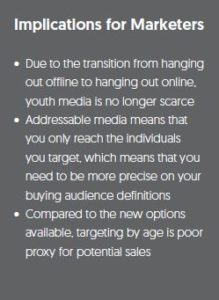Recently, marketing guru Gina Pell coined the term Perennials, “because age ain’t nothin’ but a number”. Her argument is that the days of targeting media and products at people based on their age is over.
Perennials in her mind are ever-blooming, live in the present time, know what’s happening in the world, stay current with technology, and have friends of all ages. Perennials she says are not defined by age but by mind-set. At Zenith, we believe that marketers should take this Perennial approach, eschewing age in favour of targeting not just mind-set but also behavioural change and disposal income.
We especially need to think ‘perennially’ about targeting because in recent years there has been a fundamental shift in media consumption and a revolution in the way media is traded. Historically, reaching young people was hard as their media was scarce. The only way to socialise was face to face, this meant their consumption of media was limited. Today, the mobile revolution (see table 1 opposite) means that the young connect in the virtual media world of messaging and social media apps, leading to massive declines in ‘hanging out’ since 2011 (see table
2) and providing an abundance of youth media opportunities. 
This same revolution has led to a fragmentation of audiences across multiple platforms and devices, making all audiences hard to reach through historic targeting approaches on traditional media. When you buy traditional broadcast media, what you buy is the media exposure of the audience. The price is based on the delivery of your specific target audience, but you reach other people exposed to the media. As young
people are pre-occupied elsewhere, broadcast media consumption was – and still is – biased in favour of older consumers, which used to mean a high advertiser demand for younger audiences. 
When you buy new addressable digital media, such as programmatic display and social, what you buy is an individual’s exposure to ads across different media and platforms. This is priced just on the individual ad exposures of the specific target audiences, with other individual
exposures being sold to other advertisers. Unlike broadcast media, if you buy a young audience, you are only reaching that audience. The reason that this is an issue is that compared with other targeting opportunities available today, age is a poor proxy for potential sales
conversion. This is why we need to adopt a perennial approach to targeting focusing on behavioural change, disposal income and, of course, mindset and attitude.

SIGN UP FOR ZENITH INSIGHTS




